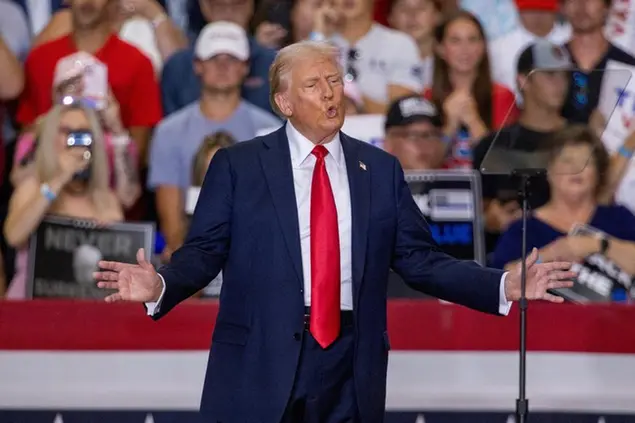PHOTO
(The opinions expressed here are those of the author, a columnist for Reuters.)
LAUNCESTON, Australia - Much of the debate surrounding the implications of a possible second U.S. presidential term for Republican Donald Trump has focused on what may happen to the U.S. and global economies.
Trump's plan to impose tariffs of 10% on virtually all imports into the United States, and as much as 50% on those from top trading partner China, have raised the spectre of higher inflation and interest rates, and a less competitive market.
But for commodities, the bigger risk of a Trump return to the White House is the response the rest of the world is likely to have to the imposition of U.S. trade tariffs.
Political leaders across the globe will be unable to sit idly by if Trump places barriers on their exports to the United States.
Any unilateral action by Trump is thus likely to be met by retaliation from U.S. trading partners, even if they are erstwhile political allies, such as countries in Europe and some in Asia, such as Japan, South Korea and even India.
If it's inevitable that U.S. trading partners respond to Trump's proposed actions by putting tariffs on imports from the United States, the main question is then what form will they take?
While major U.S. exporting companies such as airplane maker Boeing will have cause for concern, a far easier target for retaliation is likely to be U.S. commodity exports.
The United States is the world's biggest exporter of liquefied natural gas (LNG), and ranks fourth globally for exports of crude oil and all grades of coal.
A major buyer of U.S. commodities is China. If Trump were to impose tariffs of 50% on its exports, Beijing could effectively ban all commodity imports from the United States, either formally or informally.
U.S. exports of crude oil to China were 10 million barrels in July, according to commodity analysts Kpler, and that figure is expected to rise to 16.58 million barrels in August, which would be the most since April 2023.
For the first eight months of this year U.S. crude exports to China are tracking at about 309,000 barrels per day (bpd), which represents only about 3% of China's total imports, but accounts for about 7.5% of total U.S. shipments.
In other words, it would likely be fairly easy for China to stop buying U.S. crude and find alternative suppliers, such as Angola and Brazil.
But how easy would it be for U.S. oil producers to replace the loss of Chinese buyers?
Much will depend on whether other countries place tariffs on U.S. commodity exports.
Imagine if the European Union, Japan and South Korea all put a 10% tariff on U.S. crude in retaliation for Trump putting a similar impost on their exports to the United States.
The European Union, Japan and South Korea typically account for about 60% of U.S. crude exports.
By putting tariffs on U.S. crude, LNG and coal, the rest of the world could keep U.S. energy exports in the market, but force U.S. companies to either offer discounts to keep their prices competitive or lower output.
US LNG EXPOSED
U.S. LNG exporters may be more vulnerable than crude producers, given they have no alternative markets other than exports.
For China, replacing U.S. LNG would be more challenging than replacing U.S. crude, but still likely doable, given the fairly small proportion of U.S. LNG in its total imports.
In July, China's imports of U.S. LNG were 670,000 metric tons, or about 10.5% of the monthly total of 6.39 million.
For the United States, exports to China represent only about 8% of its total LNG shipments. But if Japan and South Korea are added in as well, then exports to the three main Asian buyers rise to about a quarter of the total, based on U.S. shipments in June of this year.
If tariffs were placed on U.S. LNG by the North Asian importers, it would put pressure on U.S. companies to lower prices to compensate.
U.S. coal exports have averaged about 7.5 million tons a month for the first seven months of the year, but there is no dominant buyer. Rather there is a broad range of importers that all purchase relatively small volumes.
This means that buyers of U.S. coal could probably find alternative suppliers for the small volumes involved, but U.S. exporters may struggle to find new markets should a majority of its existing buyers impose retaliatory tariffs.
Overall, the picture that emerges is one of significant vulnerability for U.S. energy exporters if we do see another trade war, given how countries could respond to the tariffs currently being proposed by the former president's camp.
Of course, Trump still has to overcome likely Democratic candidate and current vice president, Kamala Harris, in the November election, and then actually follow through on what is likely to be a widely-criticised trade policy.
But the risk remains meaningful. In 2022, Russia's invasion of Ukraine showed us what can happen when a political event roils energy markets.
If Trump is elected and does embark on a trade war, the disruption may not be quite on that scale. But commodity flows - and thus a large part of the global economy - could be impacted if the market has to adapt to an unpredictable political dynamic once again.
The opinions expressed here are those of the author, a columnist for Reuters.
(Editing by Sonali Paul)
